THEME: NATURE
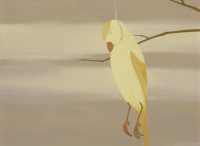 Disquieting in both its graphic content and perverse visual appeal, this work provides the conflicting experience of drawing you in while turning your stomach. A skillfully depicted, brightly colored songbird dangles lifelessly from a miniature noose strung on a bare, spindly branch. The backdrop of pale, drab clouds set against a muted sky give the unsettling feeling of either an execution at dawn or a polluted wasteland. The composition and painting style provide a disturbing variation on Northern Song (960-1126) bird-and-flower painting, which traditionally presented lively birds perched on elegant floral branches against a background of plain taupe silk. In Lili's reinterpretation, all the leaves have wilted and fallen away, and the bird has opted to take its own life. Although dramatic, the work is instilled with a sense of peace and surrender.
Disquieting in both its graphic content and perverse visual appeal, this work provides the conflicting experience of drawing you in while turning your stomach. A skillfully depicted, brightly colored songbird dangles lifelessly from a miniature noose strung on a bare, spindly branch. The backdrop of pale, drab clouds set against a muted sky give the unsettling feeling of either an execution at dawn or a polluted wasteland. The composition and painting style provide a disturbing variation on Northern Song (960-1126) bird-and-flower painting, which traditionally presented lively birds perched on elegant floral branches against a background of plain taupe silk. In Lili's reinterpretation, all the leaves have wilted and fallen away, and the bird has opted to take its own life. Although dramatic, the work is instilled with a sense of peace and surrender.
Click on the artwork for more information-
$35.00
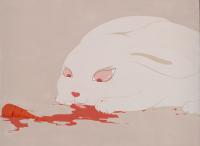 The scene is a gruesome one; a vicious creature with demonic red eyes and sharp claws eagerly laps at a gradually spreading pool of blood. Our gaze follows the trail of blood to the mangled corpse of a poor, defenseless carrot. Breathing a sigh of relief, the viewer quickly realizes that what was initially mistaken for blood is merely carrot juice and the bloodthirsty beast is just an albino bunny innocently enjoying its favorite snack. This mischievous visual duplicity typifies Lili's style and tiptoes playfully on the edge between lighthearted humor and foreboding dread. Her simultaneously cute and creepy animal subjects leave us questioning the difference and relationship between these two extremes.
The scene is a gruesome one; a vicious creature with demonic red eyes and sharp claws eagerly laps at a gradually spreading pool of blood. Our gaze follows the trail of blood to the mangled corpse of a poor, defenseless carrot. Breathing a sigh of relief, the viewer quickly realizes that what was initially mistaken for blood is merely carrot juice and the bloodthirsty beast is just an albino bunny innocently enjoying its favorite snack. This mischievous visual duplicity typifies Lili's style and tiptoes playfully on the edge between lighthearted humor and foreboding dread. Her simultaneously cute and creepy animal subjects leave us questioning the difference and relationship between these two extremes.
Click on the artwork for more information-
$35.00
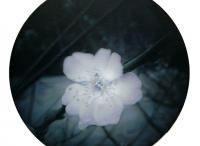 The fresh blossom in A Touch of Plum stands out against a desolate grey background of bare winter branches. While the other portraits Yang Xun's Flowers series all depict a supernatural light shining from the center of their subjects, this early bloomer appears woefully mortal. According to the artist, "The pale pink petals are tender and innocent, but in this desolate scene, seem to have bloomed in vain. This defiant but fragile blossom is bound to inspire hope for an early Spring." Yang’s Flowers series was inspired by Song dynasty flower paintings on round fans. With brilliant light and soft shadow, he uses his subjects to portray multisensory memories of attraction, hope, longing or despair.
The fresh blossom in A Touch of Plum stands out against a desolate grey background of bare winter branches. While the other portraits Yang Xun's Flowers series all depict a supernatural light shining from the center of their subjects, this early bloomer appears woefully mortal. According to the artist, "The pale pink petals are tender and innocent, but in this desolate scene, seem to have bloomed in vain. This defiant but fragile blossom is bound to inspire hope for an early Spring." Yang’s Flowers series was inspired by Song dynasty flower paintings on round fans. With brilliant light and soft shadow, he uses his subjects to portray multisensory memories of attraction, hope, longing or despair.
Click on the artwork for more information-
$35.00
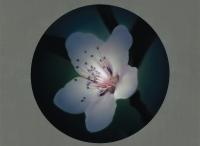 Yang Xun describes this portrait as “a peach blossom appearing from the dark like the scent of perfume left in the street; a visual sensation that reaches the viewer’s subconscious as a fragrance; a mood that gradually fills the air.” Yang’s Flower series was inspired by Song dynasty flower paintings on round fans. With brilliant light and soft shadow, he uses his subjects to portray multisensory memories of attraction, hope, pain, loneliness or despair.
Yang Xun describes this portrait as “a peach blossom appearing from the dark like the scent of perfume left in the street; a visual sensation that reaches the viewer’s subconscious as a fragrance; a mood that gradually fills the air.” Yang’s Flower series was inspired by Song dynasty flower paintings on round fans. With brilliant light and soft shadow, he uses his subjects to portray multisensory memories of attraction, hope, pain, loneliness or despair.
Click on the artwork for more information-
$35.00
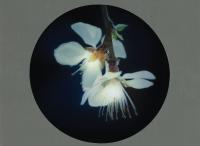 Flawless depicts two pear blossoms in full bloom, suspended from above, with supernatural light emanating from their centers. Yang Xun describes this portrait as “a memory of pure emotion, flawlessly white, but out of reach; where beauty offers hope to soften the pain of longing.” Yang’s Flower series was inspired by Song dynasty flower paintings on round fans. With brilliant light and soft shadow, he uses his subjects to portray multisensory memories of attraction, hope, loneliness or despair.
Flawless depicts two pear blossoms in full bloom, suspended from above, with supernatural light emanating from their centers. Yang Xun describes this portrait as “a memory of pure emotion, flawlessly white, but out of reach; where beauty offers hope to soften the pain of longing.” Yang’s Flower series was inspired by Song dynasty flower paintings on round fans. With brilliant light and soft shadow, he uses his subjects to portray multisensory memories of attraction, hope, loneliness or despair.
Click on the artwork for more information-
$35.00
 Chills on a Rainy Night depicts a cluster of pink blossoms against a nighttime backdrop. While the sky appears cold and overcast, a warm and unnatural light emanates from the pistil of the upward facing flower. Yang Xun describes this work as “the melancholy sight of peach blossoms on a rainy night, when long-forgotten memories can trigger a longing for someone who has disappeared from one’s life.” Yang’s Flowers series was inspired by Song dynasty flower paintings on round fans. With brilliant light and soft shadow, he uses his subjects to portray multisensory memories of attraction, hope, longing or despair.
Chills on a Rainy Night depicts a cluster of pink blossoms against a nighttime backdrop. While the sky appears cold and overcast, a warm and unnatural light emanates from the pistil of the upward facing flower. Yang Xun describes this work as “the melancholy sight of peach blossoms on a rainy night, when long-forgotten memories can trigger a longing for someone who has disappeared from one’s life.” Yang’s Flowers series was inspired by Song dynasty flower paintings on round fans. With brilliant light and soft shadow, he uses his subjects to portray multisensory memories of attraction, hope, longing or despair.
Click on the artwork for more information-
Available Soon
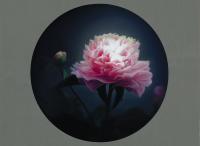 Note: This artwork is not yet available for sale, but will be soon.
Note: This artwork is not yet available for sale, but will be soon.
The Compendium of Materia Medica refers to a 16th-century compendium of medicinal herbs, compiled by Li Shizhen, a Ming Dynasty botanist and pharmacologist. According to the Yang Xun, "Peony was described in the Compendium of Materia Medica as an unambiguously beneficial herb. This medicinal aspect is overlooked because of its exquisite flower; but underneath the ostentatious petals is a staid and reliable character."
Yang’s Flowers series was inspired by Song dynasty flower paintings on round fans. With brilliant light and soft shadow, he uses his subjects to portray multisensory memories of attraction, hope, longing or despair.
Click on the artwork for more information-
$35.00








